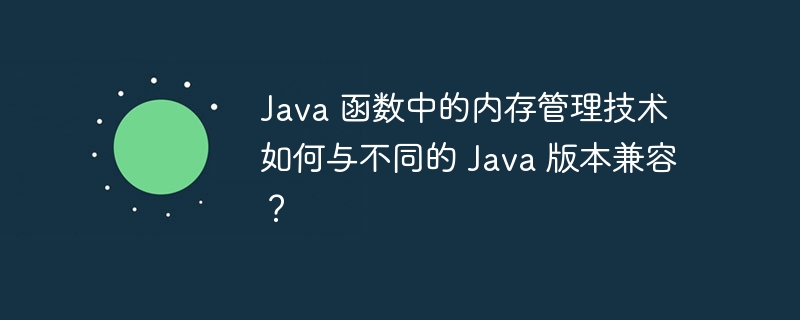Home >Java >javaTutorial >How are memory management techniques in Java functions compatible with different Java versions?
How are memory management techniques in Java functions compatible with different Java versions?
- WBOYWBOYWBOYWBOYWBOYWBOYWBOYWBOYWBOYWBOYWBOYWBOYWBOriginal
- 2024-05-03 13:18:01700browse
Java uses automatic garbage collection to manage memory. Different Java versions use different memory management technologies to improve performance and efficiency. Specific technologies include: Before Java 8: Concurrent Mark Sweep (CMS) garbage collector. Java 8: G1 garbage collector, introducing the concept of generation awareness. Java 11 and higher: ZGC (Z Garbage Collector), provides extremely low-latency garbage collection. Backward compatibility is important, and new versions are generally compatible with older versions, with exceptions: G1 is incompatible with Java 7, and ZGC is incompatible with Java 10 and earlier. Understanding memory management techniques in different versions can help optimize code and ensure that applications are compatible and stable across versions.

Memory management technology and version compatibility in Java functions
Java is a language that manages memory using automatic Garbage collection technology to remove objects that are no longer used. However, as Java versions continue to be updated, its memory management technology continues to evolve to improve performance and efficiency.
Memory management techniques in different Java versions
- Before Java 8: Concurrent Mark Sweep (CMS) garbage collector is the default collector. CMS is a concurrent garbage collector, which means it runs in the background and does not block applications. However, CMS may cause garbage collection to be paused, resulting in reduced application performance.
- Java 8: G1 garbage collector becomes the default collector. G1 is an incrementally concurrent garbage collector that can better handle large heaps of memory. It also introduces a concept called "generational sensing," in which younger objects are collected separately from older objects.
- Java 11 and above: The ZGC (Z Garbage Collector) garbage collector becomes the new low-latency garbage collector. ZGC is designed to provide very low garbage collection pause times, making it ideal for applications that require high throughput and low latency.
Compatibility Notes
While Java's memory management technology continues to evolve, backward compatibility is critical. Newer Java versions are generally compatible with older versions, but there are a few exceptions to this:
- G1: The G1 garbage collector was introduced in Java 8, and it is compatible with Java 7 Not compatible.
- ZGC: The ZGC garbage collector was introduced in Java 11 and is not compatible with Java 10 and earlier.
Practical Case
Consider the following application example using Java 8:
public class MemoryDemo {
public static void main(String[] args) {
// 创建大量对象,填满堆内存
List<Object> objects = new ArrayList<>();
for (int i = 0; i < 1000000; i++) {
objects.add(new Object());
}
// 触发垃圾回收
System.gc();
}
}When running this application in Java 8, Use the CMS garbage collector. If you run the same application using Java 11 and later, the G1 garbage collector will be used, potentially resulting in different performance behavior because G1 handles large heaps of memory more efficiently.
Conclusion
Memory management techniques in Java functions are continuously optimized to improve performance and efficiency. Although Java versions are constantly updated, maintaining backward compatibility is important to ensure that applications run stably on different versions. By understanding memory management techniques in different Java versions, developers can optimize their code to take advantage of the latest improvements while ensuring application compatibility and stability.
The above is the detailed content of How are memory management techniques in Java functions compatible with different Java versions?. For more information, please follow other related articles on the PHP Chinese website!

